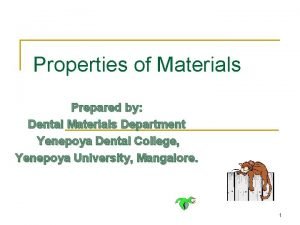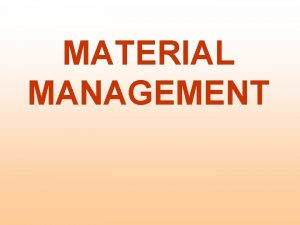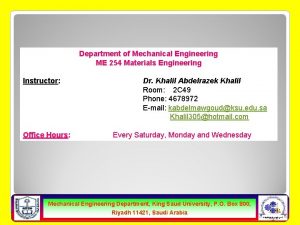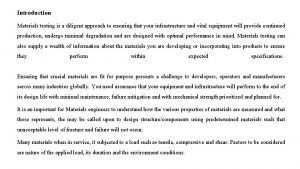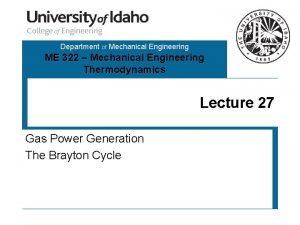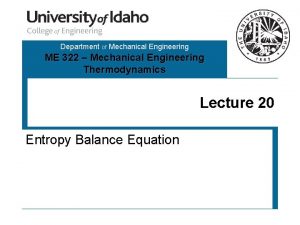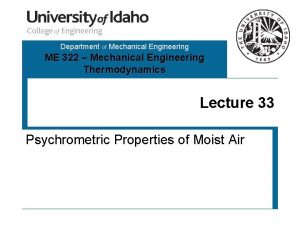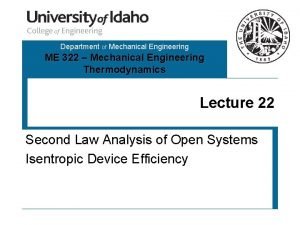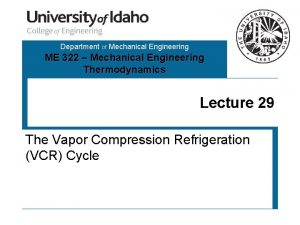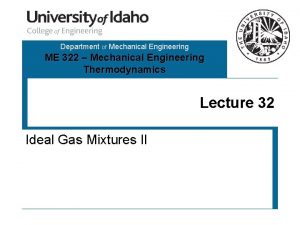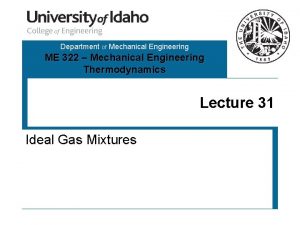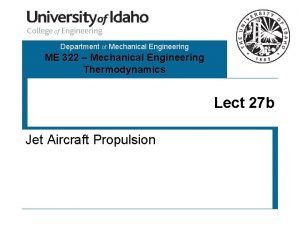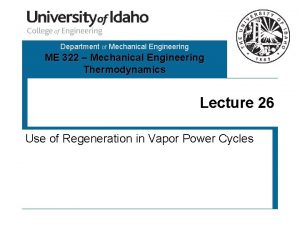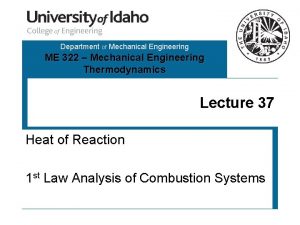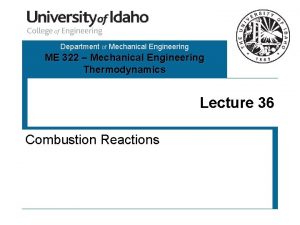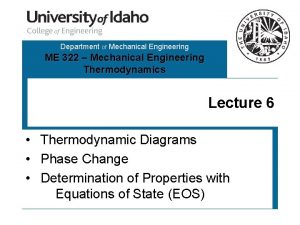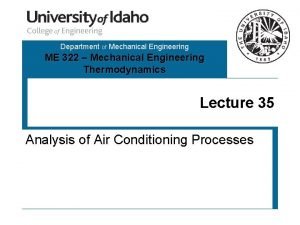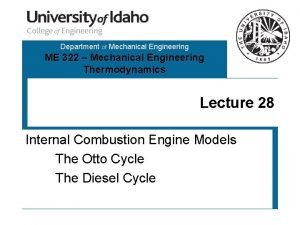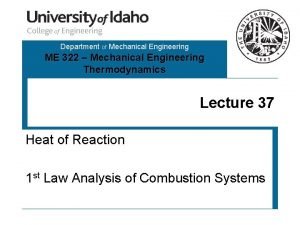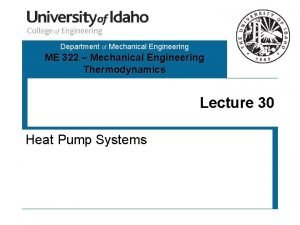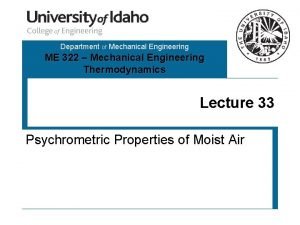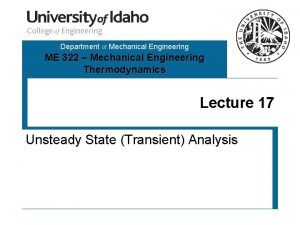Mechanical Testing Engineering Department EN Mechanical Materials Engineering






















- Slides: 22


Mechanical Testing Engineering Department (EN) Mechanical & Materials Engineering Group (MME) A. Gerardin, M. Guinchard 9/25/2020 Review of possible exchange between Hydros. ch and CERN-EN-MME 2

Introduction f f d d CERN People d “ The mandate of the Mechanical Measurement Laboratory is to provide support for the technical infrastructure of CERN, accelerators and experiments. The laboratory consists of a very complete equipment which permits a very large range of mechanical tests “In-situ” at ambient / cryogenic temperatures and in magnetic fields 9/25/2020 Review of possible exchange between Hydros. ch and CERN-EN-MME 3

Test Equipments Displacement Transducers Vibration Sensors Vibrometers (wo contact) Load / Tensile Sensors Strain Gauges Optical / Resistive Calibration tools Static and Dynamic Acquisition System Post-Processing and Analysis Parameters measured : Force , Stress, Strain, displacement, vibrations, temperature, etc. . . Environmental conditions : Magnetic field, cryogenic temperature, radiation 9/25/2020 Review of possible exchange between Hydros. ch and CERN-EN-MME 4

Test Equipments UTS 200 k. N, Frame: 250 k. N Load cells: 200 k. N, 20 k. N, 1 k. N - Tensile (RT down to 4. 2 K) Compression, Flexion, Shear, Fatigue (RT down to 77 K) Extensometer clip-on (class 0. 5) Regulation: Force, displacement, strain ZPM 500 -1000, 1 k. N ZWICK 400 k. N Load cell: I k. N Load cells: 400 k. N, 1 k. N - Compression, Flexion, fatigue (RT down to 77 K) Tensile (RT) Shear (RT) LCF (Low Cycle Fatigue, RT) Regulation: Displacement 9/25/2020 Regulation: Force, displacement, strain Review of possible exchange between Hydros. ch and CERN-EN-MME 5

CERN Applications Ø Mechanical support for LHCb vacuum chamber (C fibre tubes) Ø Mechanical stabilizer for ATLAS IBL (C fibre laminates). Ø Mechanical staves for ATLAS Inner Detector Ø Experimental Stress Analysis for satellite Ø Fiber Optical Sensor (FOS) at CERN 9/25/2020 Review of possible exchange between Hydros. ch and CERN-EN-MME 6

Supports for LHCb vacuum chamber 9/25/2020 Review of possible exchange between Hydros. ch and CERN-EN-MME 7

Support for LHCb vacuum chamber �C � fibre description: Filament winding carbon fibre reinforced epoxy tubes � Dimensions: 14 mm ID, 17 mm OD � Fibres volume fraction: 60 % � Layout : [+-8 °/90 °/+-8 °] � Fibres types: 8° orientation: Toray M 46 J 90 ° orientation: T 700 � Epoxy � Tensile resin: UF 3325 TCR and Creep Tests: 9/25/2020 Review of possible exchange between Hydros. ch and CERN-EN-MME 8

ATLAS Experiment : Pixel Detector 9/25/2020 Review of possible exchange between Hydros. ch and CERN-EN-MME 9

ATLAS Experiment : Pixel Detector 9/25/2020 Review of possible exchange between Hydros. ch and CERN-EN-MME 10

ATLAS Experiment : Pixel Detector � Description: � Carbon fibre Omega � 3 plies (K 13 C/RS 3) pre-preg fabric � Layout [0° / 90° / 0°] � Test performed to characterize assembly: � Peel test � Double lap shear tests 9/25/2020 Review of possible exchange between Hydros. ch and CERN-EN-MME 11

ATLAS Experiment : Pixel Detector � Experimental modal analysis: Experimental results @176 Hz Simulation results @227 Hz 9/25/2020 Review of possible exchange between Hydros. ch and CERN-EN-MME 12

ATLAS Experiment : Inner Detector � Experimental modal analysis: Part 1 – M 55 J (without fiber carbon crossed ) Mode Shape Frequency Damping Bending Mode@1 33. 6 Hz 0. 90 % Bending Mode@2 93. 6 Hz 0. 30% Bending Mode@3 176 Hz 0. 27% Bending Mode@4 290 Hz 0. 24% Part 2 – T 300 (with fiber carbon crossed ) Bending Mode@1 Bending Mode@2 Bending Mode@3 Bending Mode@4 9/25/2020 21. 5 Hz 60. 5 Hz 119 Hz 201 Hz Review of possible exchange between Hydros. ch and CERN-EN-MME 1. 70% 1. 30% 1. 10% 0. 50% 13

Stress analysis for POLAR detectors in satellite Carbon Socket Bi-axial gauges Scintillator bars Rosette gauges 9/25/2020 Review of possible exchange between Hydros. ch and CERN-EN-MME 14

Stress analysis for POLAR detectors in satellite Dislocation effect at 35 C for the polystyrene scintillator bars 9/25/2020 Review of possible exchange between Hydros. ch and CERN-EN-MME 15

FOS for mechanical measurements ? � � FOS applications for our lab : � Strain measurements for CERN Wide and CERN Conditions; � Civil engineering monitoring ; � Fatigue measurements on rotational machine; FOS advantages : � Electromagnetic field immunity ; � Cables reduction ; � Very long distance measurements ; � High number of FOS on the same fiber ; FOS disadvantages : � High number of FOS on the same fiber ; � Delicate fibers in our heavy environmental conditions ; � Length and radius limitations, price ; � Strain and temperature coupling effects ; Lab experience with FOS � Validation tests on tensile specimens for several temperatures (293 K, 77 K, and 4. 2 K) ; � First experience on real structure (Prototype magnet) at cryogenic temperature ; � Collaboration with ITER about mechanical measurements techniques in this field. 9/25/2020 Review of possible exchange between Hydros. ch and CERN-EN-MME 16

Our FOS experience � Installation procedure (Fiber directly on the support) FOS Selection Surface preparation and cleaning Single Mode Fiber coated with an outer diameter of 200 m - HBM Gmb. H Company with K=0. 78 +/ - 2% Polishing of the surface and cleaning with phosphoric-acid and ammonia-based liquid Fiber cleaning Cleaning with the same chemical products Fibre installation with tape Installation with Mylar tape without groove Gluing Bonding with epoxy-phenolic adhesive for a large range of temperature Mechanical pressure on the fibres Curing under mechanical load control to polymerized the glue Curing, 120°C, 5 hours 9/25/2020 Review of possible exchange between Hydros. ch and CERN-EN-MME 17

Our FOS experience � Installation procedure (Fiber directly on the support) 9/25/2020 Review of possible exchange between Hydros. ch and CERN-EN-MME 18

Our FOS experience � Validation tests at several temperatures (down to -271 C) 9/25/2020 Review of possible exchange between Hydros. ch and CERN-EN-MME 19

FOS & Electrical Strain Gauges Optical sensors Standard instrumentation DI 405 4 Channels Fs up to 1000 Hz 1510 nm up to 1590 nm 9/25/2020 Review of possible exchange between Hydros. ch and CERN-EN-MME 20

Conclusion � Our mandate : “ The mandate of the Mechanical Measurement Laboratory is to provide support for the technical infrastructure of CERN, accelerators and experiments or outside CERN through KT contract. The laboratory consists of a very complete equipment which permits a very large range of mechanical tests “In-situ” at ambient / cryogenic temperatures and in magnetic fields � Collaboration : 9/25/2020 Review of possible exchange between Hydros. ch and CERN-EN-MME 21

 Eacademics iitd ac in sportal login
Eacademics iitd ac in sportal login Dental materials
Dental materials Material management is defined as: *
Material management is defined as: * Materials department
Materials department Favourite cars
Favourite cars Materials that are useful
Materials that are useful Natural materials and man made materials
Natural materials and man made materials Adapting and adopting materials
Adapting and adopting materials Direct materials budget with multiple materials
Direct materials budget with multiple materials Clifford materials reactivity testing
Clifford materials reactivity testing Introduction to materials testing
Introduction to materials testing Domain testing in software testing methodologies
Domain testing in software testing methodologies Kv charts in software testing
Kv charts in software testing Du path testing
Du path testing Positive testing and negative testing
Positive testing and negative testing Static testing and dynamic testing
Static testing and dynamic testing Globalization testing in software testing
Globalization testing in software testing Neighborhood integration testing
Neighborhood integration testing Language testing
Language testing Control structure testing in software testing
Control structure testing in software testing Decision table testing in software testing
Decision table testing in software testing Decision table based testing
Decision table based testing Pengertian blackbox testing
Pengertian blackbox testing

